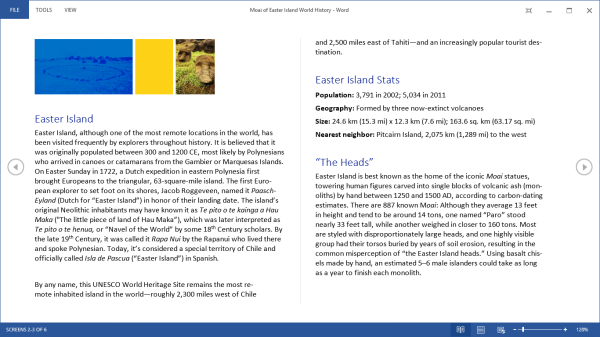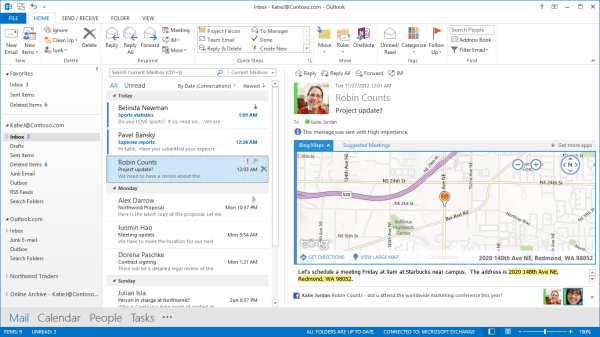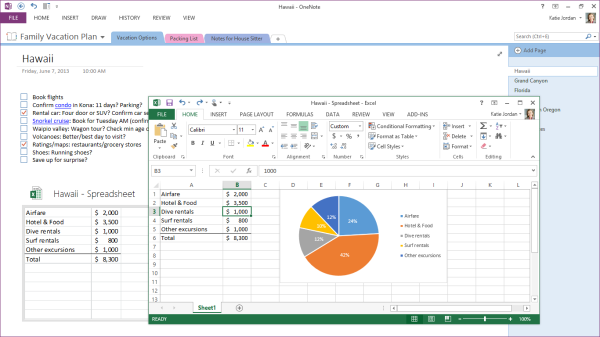Three Months with Microsoft's Office 365
by Vivek Gowri on January 31, 2013 11:59 PM EST- Posted in
- Microsoft
- Cloud Computing
- Office 2013
- SkyDrive
Word 2013 has a couple of nice features worth calling out. One is a viewing mode designed specifically for reading, which is pretty similar in theory to Reader mode in Safari, with text reflowing in columns to fit the display and all navigation and editing tools being hidden to present the document in a consumption-centric manner. The other is much better handling of PDFs - Word 2013 can now open PDFs and treat most content (text, tablets, formatting) exactly the same as standard Word docs. If you’ve ever had to deal with the nightmare of copying content from PDFs to Word, this is wonderful news. Unfortunately, now I’m done with college; it’s unfortunate that Microsoft didn’t decide to implement this in Word 2007 when it would have been legitimately useful to me. (Sidenote: perhaps this is a sign that I’m getting old, but I’ve had a number of moments in the first month of this year when I see new tech products and think to myself “Damn, I would have killed for that 5 years ago when I was an undergrad.”)
PowerPoint comes with significantly better audio and video media support, the ability to add pictures from online directly to the presentation instead of having to save and insert them, a new presenter view when you have a second screen (which is done automatically), more (and better) themes, some cool new transitions (in a category called “Exciting”), and better sharing and editing tools.
Excel’s improvements are primarily related to new charting options, but also a couple of new data tools. The new chart object styles are awesome, and the customizability of the data point styles and transparencies is much easier than it used to be. Other than new content and the visual refresh, the way you interact with the software hasn’t fundamentally changed much with the added features, which is why I’m kind of glossing over Excel and PowerPoint. They’re evolutionary improvements that don’t radically alter the user experience.
Outlook has been redesigned to look like a much more powerful version of the Windows 8 Mail application, with a colour scheme change from gold to blue. Inline replies are now the default, there are plenty of animations, and social networking integration is being touted as one of the more important new features. Clearly, this is not my father’s Outlook we’re talking about. It takes some of the better features from current mobile mail applications and integrates them into what was already the gold standard in desktop mail programs. There are new flyover boxes (called Peeks) to quickly show you schedule, calendar, or contact details without switching windows. The contact manager also does a better job of consolidating multiple contact details into a single card to reduce duplicates. Faster search, better filtering, and new views and in-line attachment and Bing map previews make the 2013 edition the sleekest and easiest version of Outlook yet. After using Outlook for a few days, going back to the Mail app is just a painful and torturous exercise.
With Office 2013, OneNote is making the jump from interesting and useful Office application to really being a vital component of the Office suite. With the rise of tablet computing and the touch-centric nature of Windows 8, this is understandable, particularly since most of the Intel-based tablets are coming with Wacom, N-Trig, or other active (pen-input) digitizers and even the Windows RT slates work well when paired with capacitive styli. That most Windows RT slates don’t come with capacitive pens out of the box is a failing of the device manufacturers, since the platform really lends itself to pen input.
OneNote 2013 features a lot of cross platform integration, with easily embedded objects and Office files (which automatically update when changed). So, if I was to put an Excel grocery list file into OneNote, any changes I made to it in Excel would be reflected in OneNote as well. Outlook meeting integration gives OneNote much more scope in the business realm than it previously had, particularly when combined with the improved search and linked audio features. Better inking, photo snipping, auto-save, and a full-page reading view just improve what OneNote was already great for.














113 Comments
View All Comments
N4g4rok - Friday, February 1, 2013 - link
It's not that bad.If you use all if the applications that usually come with the Professional editions of office, then after 4 years, you've paid the same price for five installations of it as you would have for a single one. Plus, the subscription gives you access to an upgrade when the new version comes out. Which is likely to happen in 3 - 4 years. combine that with the free Skype minutes and extra Skydrive storage, and it isn't that bad a deal.
colonelpepper - Saturday, February 2, 2013 - link
Actually it's pretty flippin terrible.I've been using office 2003 for 10 years... it works perfectly. Apart from aesthetics (which have gotten worse) there is no compelling reason for almost anyone to upgrade past 2003.
Another fact: Almost nobody "uses all of the applications" that come with Office
Another fact: The only way that microsoft can convince people to upgrade has been to implement backwards-INcompatible file formats with each successive iteration of Microsoft office.
This push for subscription-based software which you don't own is COMPLETELY TERRIBLE for user rights. Nobody, absolutely NOBODY should be defending microsoft here... it is completely inexcusable (this push for subscription based Office).
TO ANYONE CONSIDERING DOWNGRADING TO SUBSCRIPTION BASED OFFICE:
http://www.libreoffice.org/download/
Download LibreOffice! There's the link. It costs nothing. It is free of spyware (unlike office). It does everything that will satisfy the needs of 99.9999999999% of all "office users".
...where is the LibreOffice review Anandtech???
or is it corporate propaganda articles only these days?
cjl - Saturday, February 2, 2013 - link
While I agree that the office rental is a pretty bad deal, MS has not implemented "backwards-INcompatible file formats with each successive iteration of office" (or anywhere close to it, really). The formats stayed constant up through 2003, through several iterations, and then they changed once in 2007 (but they retained the ability to save in backwards-compatible formats). Then, Office 2010 and now 2013 share the same file formats as 2007, so once again, there is no forced obsolescence. In addition, Office 2007 (and later) added significant features over the older versions, so there are plenty of reasons to switch aside from mere aesthetics.As for LibreOffice? I've tried it, and unfortunately, it lacks many features compared to MS Office. It works fine for basic users (and to be honest, if you're happy with the feature set of Office 2003, you are a basic user, and LibreOffice would probably be an upgrade as far as features are concerned), but if you use some of the more advanced features in Office, it isn't really a viable substitute.
N4g4rok - Saturday, February 2, 2013 - link
When you say "subscription-based software which you don't own", i'm not entirely sure what your issue is. Ownership in all practicality is the same as buying the individual license. Yes, it's more like leasing than purchasing, but that isn't inherently a bad thing."It is free of spyware (unlike office)"
I'm not even sure what you're getting at there. It sounds a little paranoid, but the definition of spyware could be muddied to include the improvement program microsofts implements. There's an opt-out for that as well, so i don't know how your 'Spyware' accusation holds any ground.
"Nobody, absolutely NOBODY should be defending microsoft here"
Naturally, i don't agree. supporting microsoft does not immediately make you a shill or a throwaway in a debate about software companies. Microsoft isn't the evil company that some would claim they are.
Ant-Acid - Sunday, March 10, 2013 - link
So I am a sucker for being in front even after 20 yrs of "renting" Office?To get the same apps (Word, Excel, Powerpoint, Onenote, Outlook, Access, And Publisher.) as a once off purchase for 1 PC is ~$550 here in Australia.
Now multiply that by the 5 PC's that we each have in my house.
That's $2750.
Now divide that by $119 for Office 365 HP. That's ~23 years of "renting" and then I am starting to better off purchasing outright, and I don't have to find $2750 right now.
The subscription is for the *current* version (read: free upgrades) as well.
tipoo - Friday, February 1, 2013 - link
All that white is an eyesore.steven75 - Sunday, February 3, 2013 - link
You just don't get it, maaaan. He *designers* say everything should be endless white space. That's like, what the future is. Nothing with be distinguishable at a glance--just white space as far as the eye can see!nalim - Friday, February 1, 2013 - link
"It’s been six years since they debuted, so anyone that is still complaining about Ribbon UI should really get over it, especially now that Windows Explorer uses it as well."What a lame logic!
JediJeb - Sunday, February 3, 2013 - link
Just because some people find the Ribbon to be lame does not make them lame themselves. Everyone has a different way of thinking, and to some the Ribbon is illogical at best.If everyone's thought process was exactly the same, there would only be one style of house, one style of automobile, one type of computer, one type of food, ect. What one finds stupid and useless another finds perfectly logical and useful. You like the Ribbon, some don't. Thinking everyone should is the lame logic here.
Arbie - Friday, February 1, 2013 - link
Is this about you or about Office 365?